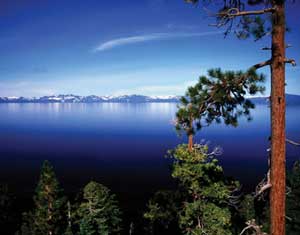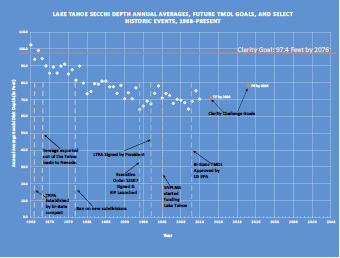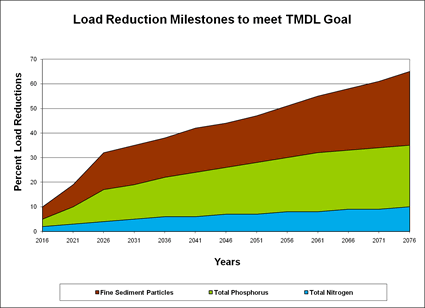Contact EPA Pacific Southwest Water Division
Pacific Southwest, Region 9
Serving: Arizona, California, Hawaii, Nevada, Pacific Islands, Tribal Nations
Watershed Priorities - Lake Tahoe, CA & NV

Photo courtesy of Tahoe Regional Planning Agency (TRPA)
Tools and Programs
On this page:
TMDL
Lake Tahoe's clarity is world renowned and well documented. The lake has experienced a decline in water clarity since the late 1960s. A plan to reverse this decline and restore deepwater clarity to historic levels—known as the Lake Tahoe Total Maximum Daily Load or TMDL—was adopted by the States of California and Nevada, and approved by the U.S. Environmental Protection Agency (EPA) on August 16, 2011. Prior to approving the TMDL EPA Region 9 consulted and coordinated with the Washoe Tribe of Nevada.
The TMDL's implementation plan guides restoration efforts for a number of sources of pollutants responsible for the clarity decline. The plan calls for fine sediment, phosphorus, and nitrogen pollutant load reduction projects to be implemented by state departments of transportation and local municipalities, land and stream resource management agencies, and air quality regulators.
The TMDL and its Implementation Plan resulted fromf a ten-year development effort funded by state and federal agencies. Both the scientific research and stakeholder input that underpin the final restoration plan are among the most advanced ever applied to a TMDL in the nearly 40-year history of the Clean Water Act.
The Lake Tahoe TMDL:
- identified the relative contributions of fine sediment, phosphorus, and nitrogen inputs to Lake Tahoe from major pollutant sources;
- calculated the load reductions needed from the four largest sources (urban and forest stormwater runoff, stream channel erosion, and atmospheric deposition) to achieve both the TMDL numeric and interim (Clarity Challenge) targets of 97.4 and 78 feet (29.7 and 24 meters) respectively; and
- identified a strategy to achieve pollutant load reductions needed to restore lost clarity.
TMDL Links
- EPA Press Release
- California Lake Tahoe TMDL (PDF) (380 pp, 5.86MB)
- California Lahontan Regional Water Quality Control Board

- Nevada Lake Tahoe TMDL (PDF) (338 pp, 5.1MB)
- Nevada Division of Environmental Protection, Bureau of Water Quality Planning

- More information on TMDL's
- Video: Charting the Course to Clarity

The "Lake Tahoe Clarity DVD" was produced in 2010 and focused on the beauty of Tahoe and the causes for its declining clarity. Since its release, the Lake Tahoe Basin has experienced a downward trend in its local economy, as has much of the country. Therefore, the cost estimate given in the DVD for implementing the TMDL for fine sediment particles and nutrients, is now outdated. We will be working with our state and local partners to produce a follow up DVD which will bring to light the economic realities of implementation in the context of a weak economy and re-analyze the costs for implementation.
Management Actions Taken
- Establishment of the Clarity Challenge which is an interim goal to achieve 80 feet of clarity within 15-20 years and considers the opportunities for achievable load reductions in all source categories.
- Development of a suite of urban stormwater tools including a hydrologic load reduction simulation model to aid in the development and selection of alternative project design scenarios, as well as rapid assessment methodologies to help jurisdictions determine the relative condition of stormwater assets and to prioritize and evaluate maintenance activities.
- Development of protocols and methods facilitating the consistent estimation and tracking of progress toward achieving restoration goals.
- Development of a TMDL Management System to incorporate new monitoring, scientific and research information and ensure continual improvement and adaptive management occurs throughout implementation of the Lake Tahoe TMDL.
Implementing the TMDL
The CA Water Board and NV DEP are the two state regulatory agencies that oversee implementation of this TMDL. These two agencies may enact policy and regulations based on the TMDL analysis and key scientific findings of the TMDL. Each agency uses its regulatory authority and non-regulatory programs (see funding section below) to ensure that the performance objectives specified in this TMDL are achieved.
Achieving the interim Clarity Challenge—load reductions expected to improve Secchi disk depth by nearly ten feet—necessitates substantial reductions from all source categories, particularly urban stormwater runoff. The Lake Tahoe TMDL has blazed new ground by developing a comprehensive method for estimating, tracking and reporting progress from on-the-ground pollution control activities. Urban stormwater jurisdictions are expected to prioritize and implement needed load reductions at the catchment or neighborhood scale, as well as to verify and obtain credit for these activities through the Lake Clarity Crediting Program. Tracking protocols and performance measures are in place or under development for the other source categories, facilitating the evaluation and assessment of progress toward meeting load reduction goals and enabling greater transparency and accountability for the expenditures of public monies.
The following is a representative list of practices and treatment options that responsible parties might use to meet the Clarity Challenge load reductions by 2026, and achieve the TMDL in 2076. Many of these practices are already in use by responsible parties, and an enhanced level of effort may contribute to reduced sediment and nutrient discharges to Lake Tahoe. In the future, technological advances may add other actions to this list. This list is not intended to be exclusive; implementing agencies may select other actions to achieve required load reductions. Please refer to the State's TMDL Section 11.3 for more discussion on implementing the TMDL.
- Stabilize and re-vegetate road shoulders and eroding slopes
- Implement an aggressive street sweeping program with high-efficiency street sweepers
- Upgrade/enhance fertilizer/turf management practices to reduce nutrient application
- Remove impervious coverage (increase infiltration)
- Apply advanced deicing strategies (to reduce or eliminate abrasive application) Upgrade/increase/enhance infrastructure operation and maintenance
- Redirect runoff for additional treatment
- Install and maintain infiltration systems
- Install and maintain detention basins
- Install and maintain sand filters
- Control retail fertilizer sales within the Basin
- Recommend landscaping practices that reduce nutrient mobilization
- Install and maintain wet basins / infiltration basins
- Install and maintain constructed wetlands
- Install and maintain media filters in stormwater vaults
- Pump stormwater to more suitable treatment locations
- Put gravel on unpaved roads and pave dirt roads at access points
- Reduce residential wood burning with incentive programs
- Mulch and revegetate ski runs
- Decommission and re-contour existing roads and trails
- Implement stream restoration project and reconnect floodplains
Environmental Improvement Program (EIP)

Tahoe Regional Planning Agency (TRPA) ![]() launched the EIP
launched the EIP ![]() in an effort to better implement the Regional Plan and highlighted it at the Presidential Forum at Lake Tahoe in 1997. Recognizing that capital investments, research, and monitoring were essential components of the Regional Plan, the original EIP called for an investment of $908 million in capital projects and $58 million in research and monitoring. The EIP also identified hundreds of specific projects and programs to be undertaken by more than 50 funding partners, including federal, state, and local agencies and the private sector. The projects were focused on improving air, water, and scenic quality, forest health, fish and wildlife, and public access to the Lake and other recreation areas. The prime directive of the EIP was to move the Tahoe Basin closer to environmental threshold attainment.
in an effort to better implement the Regional Plan and highlighted it at the Presidential Forum at Lake Tahoe in 1997. Recognizing that capital investments, research, and monitoring were essential components of the Regional Plan, the original EIP called for an investment of $908 million in capital projects and $58 million in research and monitoring. The EIP also identified hundreds of specific projects and programs to be undertaken by more than 50 funding partners, including federal, state, and local agencies and the private sector. The projects were focused on improving air, water, and scenic quality, forest health, fish and wildlife, and public access to the Lake and other recreation areas. The prime directive of the EIP was to move the Tahoe Basin closer to environmental threshold attainment.
Lake Clarity Crediting Program
Lake Clarity Crediting Program Handbook ![]()
TMDL & Stormwater Accounting Video ![]()
The Lake Clarity Crediting Program establishes the framework that connects on-the- ground actions to the goal of restoring Lake Tahoe clarity. It defines a comprehensive and consistent accounting system to track pollutant load reductions from urban stormwater using Lake Clarity Credits. The Crediting Program aligns policies with ongoing implementation in order to drive accountability and motivate effective action to improve Lake Tahoe clarity.
Lake Tahoe TMDL Management System
To ensure implementation proceeds efficiently, the Lake Tahoe TMDL Program established an adaptive management system, a formal process to enable programmatic and/or policy adjustments. Adjustments may be triggered by changing political or economic environments, new scientific findings, input from TMDL stakeholders, or an unforeseen future condition caused by climatic, geologic or wildfire events. The TMDL Online Interface ![]() is the central hub for information related to the Lake Tahoe TMDL Program and the TMDL Management System.
is the central hub for information related to the Lake Tahoe TMDL Program and the TMDL Management System.
Lake Tahoe Nearshore Evaluation and Monitoring Framework
In response to nearshore degradation, a multiagency partnership including the Lahontan Water Board, Nevada DEP, TRPA, and EPA collaborated with the foremost experts on Lake Tahoe’s nearshore to produce the Lake Tahoe Nearshore Evaluation and Monitoring Framework ![]() (October 2013), and to develop the Lake Tahoe Nearshore Water Quality Protection Plan
(October 2013), and to develop the Lake Tahoe Nearshore Water Quality Protection Plan ![]() (June 2014), which includes the following elements:
(June 2014), which includes the following elements:
- continue implementing programs that benefit nearshore environmental quality (e.g. the Lake Tahoe TMDL and the TRPA Regional Plan);
- establish and implement an integrated nearshore monitoring plan to track change in the nearshore environment and track pollutant inputs to the nearshore;
- evaluate localized “hotspots” where nearshore change has been documented and assess causes of observed degradation;
- investigate climate change influence on nearshore water quality; and
- assess the need for revised or new water quality standards to protect nearshore water quality


